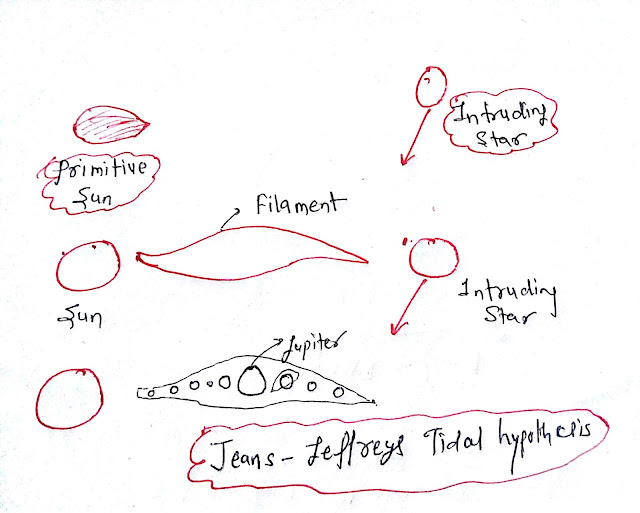Question.
Discuss the tidal hypothesis of Jeans and Jeffreys regarding the origin of the earth. ( UPPSC / UPPCS, 2018, 15 Marks)
Review the tidal hypothesis of the origin of the earth. ( UPPSC 1995)
Answer.
We have four major early hypotheses to explain the origin and evolution of our solar system including Earth.
- Nebular hypothesis(1796)
- Chamberlain and Moulton's Planetary Hypothesis (1905)
- Tidal Hypothesis(1919)
- Binary Star Theory (1950)
The tidal hypothesis is one of the four major early hypotheses and is an extension of Moulton's planetary hypothesis. The tidal hypothesis was propounded by James Jeans and Harold Jeffries in the year 1919. Jeans and Jeffrey were both British scholars.
 |
| Jeans and Jeffreys's tidal hypothesis |
As per Jeans and Jeffrey's regarding tidal hypothesis:
- Our solar system is made up of the Sun and an intruding star. The formation of our solar system is the result of the gravitational pull between these two stars.
- Primitive Sun: The initial phase of the Sun is called the Primitive Sun and it was stationary and rotated on its axis.
- Intruding Star: It was much larger in size than the primordial Sun. This star was moving and came closer to the primitive Sun.
- When the intruder star passed from the primordial Sun, a tide of hot gaseous mass erupted from the primordial Sun.
- When the intruding star was closest to the Sun for its entire travel distance, cigar-sized hot gaseous particles separated from the primordial Sun. The shape of the cigar was called "filament" by Jeans and Jeffrey.
- The central parts of the filament were bulged and contained more gaseous material, so large planets such as Jupiter and Saturn were formed from the central part of the filament.
- Small planets were formed on either side of the filament because there was less gaseous material than in the central part.
- Minor planets such as Mercury and Venus did not have any natural satellites, because the minor planets cooled very rapidly.
- Due to the medium size of the planet Earth, only one natural satellite was formed.
- Larger planets like Jupiter and Saturn have many satellites because they are larger in size and took longer to cool down.
Evidence that supported the Tidal Hypothesis:
The following are pieces of evidence in the support of tidal hypothesis:
- It is able to correctly explain the order and size of the planets. As the hypothesis correctly states, there is a large planet in the middle of the filament and the size of the planet decreases as we move from the middle of the filament.
- It is able to correctly explain the number of natural satellites. As the tidal hypothesis correctly pointed out, the smaller planets either have no satellites or have very few satellites because they cooled too fast and the larger planets have many satellites because they took longer to cool.
- All the planets in our solar system are revolving around the Sun in the same direction (counter-clockwise), in this direction the filament was also used to revolve.
- Except for Venus and Uranus, all the planets are rotating on their axis in the same direction (west to east).
Evaluation or Criticism of tidal hypothesis:
Although the hypothesis is simple and logically correct however there are major criticisms:
- The planets in our solar system are made of heavy nuclear material, but according to the hypothesis, the material of the planets came from the Sun, but the hypothesis does not tell from where the heavy atomic material of the planet came from. According to the hypothesis, all the planets should be made of matter like helium and hydrogen, but it is not so.
- The stars are so far away in the universe that the chances of star intrusion are very very small.
- The hypothesis did not give much information about the intruder star such as the source and destination of the intruder star.
You may like also:
ConversionConversion EmoticonEmoticon